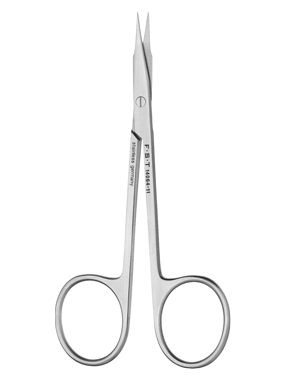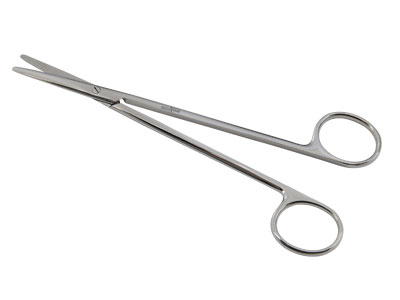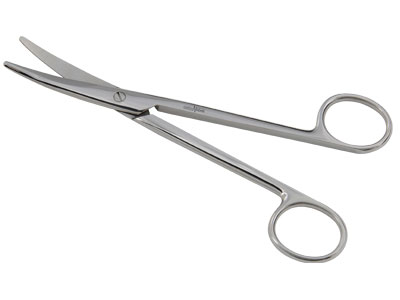

The Different Types of Surgical Scissors and Their Uses
The History Behind Surgical Scissors
If you are injured now, in the process of your recovery, you might come in contact with a number or surgical and health surgical scissors. Don’t be alarmed! They are there to help.
If you were injured some 5,000 years ago however, it would not be uncommon to go to a health care provider, only to be treated with palm bark, linen bandages, wood, and clay.
It was not until the days of Hippocrates, known as the father of modern medicine, that classical surgery as we know it, came about. All of a sudden, tools made of hardened iron, copper, bronze and brass were having patients thinking, “they were healing us with what?” There has been such a progression in the tools that according to Helmut Kapczynski’s Surgical Instruments 101, “some reports indicate the existence of as many as 200 instrument types.” The progress did not end there.
Following the decline of the Greek civilization, the Roman Empire picked up the pieces. But it was not until the 1700’s that surgery became a discipline of its own. In the 1800’s, the growing field found it’s center in Paris, France, while Tuttlingen, Germany became a center for instrument production. Upon the Industrial Revolution, advancements continued and allowed the tools to be more widespread.
Now, surgical scissors play a large part in operations, and are almost always on the table, as they act to dissect tissue, remove or shift bones, tissues, and other materials.
Materials
Stainless Steel
Through such drastic evolution, tools are now produced with a variety of materials for different purposes.Stainless steel is an ever popular material for surgical scissors, as it is rust-resistant, strong, and durable.Within its category, however, even stainless steel has a range of material styles, depending on the amount of carbon content, along with other factors that generate different levels of flexibility, hardness, and malleability in the final instrument. Due to the material’s large amounts of chromium, the surface is protected from corrosion, which is a great benefit and a reason that the material is often times the leading choice when it comes to surgical instruments. Other components of steel include silicon, manganese, phosphorous, and sulphur.
Tungsten Carbide
Although stainless Steel is built to be durable, tungsten carbide is five times harder, making for impressive durability. Tungsten carbide, also known as TC, is often times attached through welding to the ends of the surgical scissors. If soldered to an instrument, TC can be detached and replaced if worn down over time. If the TC is welded however, the instrument is irreplaceable. The strength and hardness of the material allows sharper edges to be manufactured, allowing for smoother cuts and further material durability.
Titanium
This material’s biocompatibility is light weight, which gives surgeons more wiggle room and less fatigue. Although it is more expensive than some other materials, it is becoming increasingly more popular among surgical scissors. These tools are built to be sustainable, but maintenance and cleanliness are still the keys to keeping them in tact.
The Different Types of Surgical Scissors
Bandage Scissors
Bandage scissors, used to cut gauze, bandages, and size bandages, are designed with the patient’s safety in mind. By having an angled tip and a blunt bottom tip, the scissor is designed specifically to cut through thin material without cutting the skin. Between bandage scissors, there are two main types, including the Lister and the Knowles. The former is used most for sizing dressings and removing bandages, along with cutting through thicker materials such as plaster, fabric, and umbilical cord. The lower blade on the jaw is elongated and the tip holds a flattened blunt nodule, meant to slide between bandages and skin, being conscious of skin safety. This multipurpose feature allows the instrument to be used during cesarean section, opening the uterus while protecting the baby. Similarly, knowles bandage scissors are lightweight, durable, and made to cut through thick materials, with a tip on the upper blade, as to protect the patient. The blades are closer in size and shape than the Lister.
Dissecting Scissors
Providing more mechanical leverage than scalpels, dissecting scissors come into play in making incisions, removing skin, tissue and stitches. With a curved blade, they are able to protect incisions during probing. Heavy blades are meant for cutting thick tissue such as tendons and ligaments. Delicate structures, like eye tissue, should be used by lighter blades, shapes ranging from straight, angled, or curved. According to Jessica Gore, writer of wiseGEEK.net, iris and tenotomy are some of the lightest dissecting scissors, the former with a fine and sharp tip for meticulous work, while the latter is used more to push tissue aside, rather than pierce it.
Iris Scissors
Iris scissors are very small instruments with a very sharp and fine tip, meant mostly to be used during ophthalmic surgery, but certainly not exclusively, as they are ideal for removal of fine tissue and suture, OB/GYN procedures, and dermatologic procedures. Curved and straight blades might be available, depending on the procedure.
Operating Scissors
Operating Scissors are general medical scissors that allow for variety in size, and design, depending upon operation. In some cases, they might be the perfect tool for regular use as well as surgical purpose. Most popularly made of stainless steel, they must be cleaned and sharpened regularly.
Stitch Scissors
This instrument is perfect for removing suture. A hook shaped tip on one blade allows for easy entry under the suture, in order to lift and separate from the skin before cutting. The hook should hold the suture to prevent slippage from the blade before it is time for the suture to be cut. You might also find the stitch scissor with straight shanks and angled, serrated jaws, as another alternative.
Tenotomy Scissors
Tenotomy scissors are used in delicate procedures such as ophthalmic surgery, plastic surgery and even neurological procedures. With long handles, surgeons are able to feel comfortable with a firm grip while getting into small areas. This scissor comes in a variety of shapes and sizes. Sharp tips render precise dissection, while blunt tips are better for dealing with membranes.
Metzenbaum Scissors
These scissors are named after Myron Firth Metzenbaum, M.D., an American surgeon who specialized in oral and reconstructive surgery. Close in style to the Mayo scissor, the Metzenbaum surgical scissor has matching ends, but longer handles, with a narrower mid section. Most common in organ operations and also in heart operations, the metzenbaum scissor is designed for cutting soft tissue as well as blunt dissection. The blades can be both curved and straight but the tip will always be found blunt. Ranging from 4.5 inches to 14 inches long, the variety allows for different procedures, the smaller sizes best for more delicate procedures.
Pott’s Scissors
Used in vascular and cardiac surgery, these scissors specialize in the cutting of delicate pieces. Commonly used alongside the number 11 blade or the number 15 blade to get the incision going, these elongated scissors finish the job up with their angled jays which come in different sizes and angles.
Mayo Scissors
Mayo scissors, typically made of stainless steel or titanium with a polished or brushed finish, come in a variety of sizes, are typically used to cut into fascia, a tri-layered band or sheet of connective tissue fibers between the skin and muscles. Mayo scissors have a semi-blunt end. Differences appear in the type of blade, however, with a straight-bladed Mayo scissor and a curved-bladed Mayo scissor. The Straight-bladed Mayo scissor is meant for cutting tissue closer to the surface, as well as cutting sutures, giving it the name “suture scissors”. Curved-bladed Mayo scissors allow for deeper penetration than straight bladed scissors. Tissues found in the uterus, muscles, breast and foot are ideal for Curved-bladed Mayo scissors to cut through. When used for dissection, Mayo scissors are inserted into tissue tips closed at first. They are later opened once inside, to spread out the tissue.
Now, then. We have scratched the surface, cut into, and dissected some of the most well known surgical scissors. Next time you need to do some cutting, will you know which silver slicers to pick up?
References:
Kapczynski, Helmut. “Surgical Instruments 101: An Introduction to KMedic Certified Instruments.” (1997): n. pag. Web. <http://www.teleflex.com/en/usa/pdf/KMedic_Surgical_Instruments_101.pdf>.
Gore, Jessica. “What Are Dissecting Scissors?” WiseGEEK. Ed. Michelle Arevalo. N.p., 5 Jan. 2016. Web. 19 Jan. 2016. <http://www.wisegeek.net/what-are-dissecting-scissors.htm>.
TheYellowCode. (2010, August 13). Handling Potts Scissors [Video file]. Retrieved from https://www.youtube.com/watch?v=Ct45A6M6LS8









One thought on “The Different Types of Surgical Scissors and Their Uses”
Comments are closed.